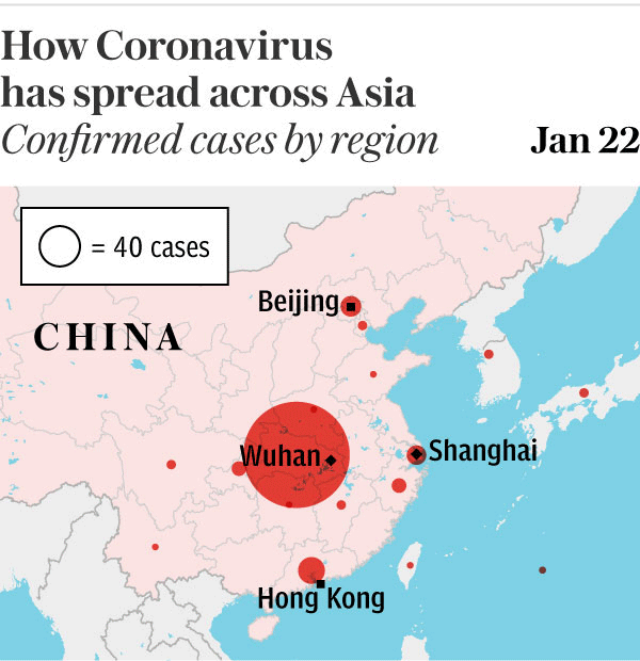Coronavirus infection: everything you need to know about the outbreak from China

A new coronavirus has broken out in China, infecting more than 9,600 people and killing 213. As authorities fight to contain the virus, experts warn that the death toll will almost certainly rise.
The disease, which causes pneumonia-like symptoms, has forced Beijing to quarantine 18 major cities, essentially locking down more than 56 million people.
Here's everything you need to know about the virus.
What is the coronavirus?
Coronaviruses are a family of viruses that cause illnesses ranging from a cold to more severe diseases. Typically, symptoms include a fever, fatigue, sore throat and dry cough, and may later develop into breathing difficulties.
These viruses are transmitted between animals and people. This novel coronavirus, currently named 2019-nCoV, is a new strain that had not been previously identified in humans.
Where and when did the infection start?
The source of the coronavirus is believed to be a seafood market in the central Chinese city of Wuhan. The city's health commission said the infection broke out between December 12 and 29, with some of the patients employed at the market.
The animal source of the outbreak has not been identified but two recent research papers have pointed to bats and snakes as the possible culprits.
The market in Wuhan, now shut down, was home to stalls trading in many different animals, including snakes, marmots and poultry. These “wet” markets are popular in China as customers like to purchase their meat “warm” - that is, recently slaughtered.
Here's how the virus can spread:
How far has it spread?
While most people affected are in China, cases in this fast-moving outbreak have now been found in the United States, France, Australia, Hong Kong, Thailand, Malaysia, South Korea, Taiwan, Macau, Japan and the Philippines. Fourteen people are being tested in the United Kingdom.

How quickly has it spread?
Since the outbreak in mid-December, cases have escalated at pace. Within a month, two people in China had died while about 40 cases were identified. As of January 28, the death toll stood at 213 with more than 9,600 cases.
The city of Macau, a gambling hub hugely popular with mainland tourists, has confirmed five cases as of Sunday. In Hong Kong, six people are known to have the disease and Taiwan has uncovered five cases so far.
As of January 27, the virus has continued to spread internationally, with the United States recording five confirmed cases. and Canada confirming its first case.
Singapore has five while Nepal has identified its first, Thailand its eighth and Cambodia has one. Sri Lanka confirmed its first case of the virus on Monday
Elsewhere in Asia, Taiwan has uncovered four cases so far, South Korean media reported the country's forth case, and Vietnam confirmed two cases. Malaysia and Japan have both confirmed four cases.
Australia has confirmed it has five confirmed cases of the virus.
In Europe, France has confirmed three cases while Germany has recorded one case so far.
The World Health Organisation (WHO) declared a global health emergency on January 30, which could see emergency measures put in place. Dr Tedros Adhanom Ghebreyesus, said the decision to declare an emergency was prompted by the spread of the virus to countries with weaker health systems.
“The main reason for this declaration is not because of what is happening in China,” said Dr Tedros. “Our greatest concern is the deportation of the virus … to countries with weaker health systems and which are ill prepared to deal with it.”

How many people are infected?
Currently, there are more than 9,600 cases.
How many people have died?
At least 213 people have died. Most experts expect this number to rise and there is concern that China is not being honest about the spread and potential impact of the virus.
Is there a vaccine?
No. And some pharmaceutical experts have warned that a vaccine could be years in the making. Beijing was quick to share what it knew about the virus's genetic code, which means researchers in the US and China have already begun working on a vaccine. However, any vaccine may not be available for up to a year and priority would go to health workers most at risk of contracting the virus.
Professor Robin Shattock, from Imperial College London, said his team had “two vaccine candidates” developed from the genetic sequence of coronavirus provided by Chinese scientists, and some British experts are confident that a vaccine could be available within weeks.
Prof Shattock told Radio 4’s Today programme the vaccines would be ready for use in “animal models” by the middle of next month and they were ready to “rapidly move those into human studies” if required.
For now, it is a case of containment. China has started building a hospital to treat only patients with the virus which it hopes to finish within days.
Is this virus like Sars?
Yes and no. Like all the devastating disease outbreaks of recent years, including HIV and Ebola, coronaviruses emerge from animals – in the case of Sars (severe acute respiratory syndrome) the disease jumped from bats to civet cats, a delicacy in parts of China, to humans. And in Mers (Middle East respiratory syndrome) the disease leaped from bats to camels to humans.
Sars, first reported in China in 2002, spread to 27 countries, infecting around 8,000 people and killing 700. It spread quickly but then appeared to run itself out.
Mers on the other hand, is more tenacious. It first emerged in 2012 in Jordan and about 2,500 cases of the disease have been identified so far. It is more deadly than Sars, and has claimed about 850 lives in total.
Like Sars, and unlike Mers, this coronavirus presents symptoms which make it easier to identify.
There is no vaccine for Sars or Mers that is both safe and effective in humans.
China is keen to avoid the international anger it provoked in its slow response to Sars. At the time it was accused of covering up the outbreak.
Is the virus in the UK?
The NHS has said that 161 people have tested negative for the virus as of January 30. Of 1,466 passengers and 95 staff who arrived in the UK from Wuhan between January 10 and 24, some 162 have already left the UK and 760 are now outside the 14-day incubation period for the virus.
Around 150 Britons were brought back from Wuhan on January 30 and quarantined.

What is being done for Britons in China?
More than 80 Britons on an evacuation flight from the Chinese city at the centre of the coronavirus outbreak are due to land in the UK on Friday afternoon.
After several delays, the flight - chartered by the Foreign and Commonwealth Office (FCO) - left Wuhan at 9.45am local time on Friday, carrying 83 Britons and 27 non-UK nationals, mostly from EU countries.
The flight is expected to arrive at the Brize Norton RAF base in Oxfordshire around 1pm, the FCO said in a statement.
The evacuation came after the UK's four chief medical officers raised the risk level of the illness from low to moderate and the World Health Organisation (WHO) declared an international public health emergency.
The British passengers on the evacuation flight - who have mainly been in Wuhan and the surrounding Hubei province - had to sign a contract agreeing to isolation before they could board the flight, and underwent temperature checks.
Further evacuation from Wuhan.
https://t.co/lD3Nm9E4h4#Coronaviruspic.twitter.com/phWrycLQxS— Flightradar24 (@flightradar24) January 31, 2020
On arrival, they will be taken by bus to Arrowe Park Hospital on the Wirral for a quarantine period of 14 days, where they will be housed in an NHS staff accommodation block with access to the internet.
Anyone with suspicious symptoms will be taken to the Royal Liverpool and Broadgreen Hospital, which has a high-level infectious diseases unit.
After the British passengers disembark at Brize, the flight will continue to Spain, where EU countries will process the non-British evacuees.
"It's welcome news that our evacuation flight has now left Wuhan," Foreign Secretary Dominic Raab said.
"We know how distressing the situation has been for those waiting to leave. We have been working round the clock to clear the way for a safe departure. The welfare of those trapped and public safety have been our overriding priorities."
Officials had been working to secure a flight out of Wuhan for British nationals after one planned for Thursday failed to get clearance from Chinese authorities.
Mr Raab said officials had "been working tirelessly" to get citizens out of Wuhan. The PA news agency understands the FCO tried to ensure families can remain together and relatives with dual citizenship are allowed on the flight.
British citizen Chris Hill, who lives in Wuhan with his wife and four-year-old daughter, told PA he refused to take the offered flight as the FCO could not confirm he would be able to bring his daughter Renee with him as she is a Chinese citizen.
"With the current situation and the way the FCO is handling the diplomatic side of things, I'm just losing faith," Mr Hill said.
The Chinese government does not recognise dual nationality, and it is believed people with Chinese citizenship were unable to leave the affected area.
PA understands the Chinese government later relaxed its policy on whether dual nationals and dependents could board the repatriation flight.
Protect yourself and your family by learning more about Global Health Security. And sign up to our weekly newsletter here.
